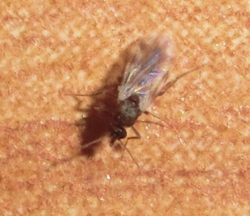| Highland midge | |
|---|---|
 | |
| Scientific classification | |
| Kingdom: | Animalia |
| Phylum: | Arthropoda |
| Class: | Insecta |
| Order: | Diptera |
| Family: | Ceratopogonidae |
| Genus: | Culicoides |
| Subgenus: | Culicoides |
| Species: | C. impunctatus |
| Binomial name | |
| Culicoides impunctatus Goetghebuer, 1920 | |
| Synonyms | |
| |
The highland midge (scientific name: Culicoides impunctatus; Scots : Midgie; Scottish Gaelic : Meanbh-chuileag) is a species of biting midge found across the Palearctic (throughout Britain, Ireland, Scandinavia, other regions of Northern Europe, Russia and Northern China) in upland and lowland areas (fens, bogs and marshes). In the north west of Scotland, and down the Western coast to north Wales, the highland midge is usually very prevalent from late spring to late summer. [1] Female highland midges are well known for gathering in clouds and biting humans, though the majority of the blood they obtain comes from cattle, sheep and deer. [2] The bite of Culicoides is felt as a sharp prick. It is often followed by irritating lumps that may disappear in a few hours or last for days, depending on the individual.
Contents
Following Scotland's exceptionally cold winter in the early part of 2010, scientists found that the prolonged freezing conditions, rather than reducing the following summer's midge population in the Scottish Highlands, in fact increased it as the cold weather had reduced the numbers of its natural predators, such as bats and birds. [3]
